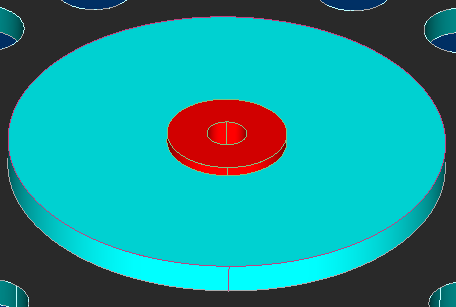Effect of Bass Port with Open, Damped and Blocked Frame Vents
Previously, we saw that when the frame vents were damped, we encountered a drop in the fundamental resonance of the driver and discussed a possible influence of the bass port, which would be the only remaining undamped port connecting the air directly behind the diaphragm to the outside.
In our real drivers, the bass port is actually an array of holes stamped through the backplate of the motor. This is presumably to provide some additional cooling to the voice coil as well as to provide a bass port function. In the model, this is a single central port running through the motor parts - a strategy previously observed in other drivers.
|
Real Motor - Motor Vents
|
Simulated Bass Port |
A simple way to understand the effect of these holes/ ports is to block them up and compare the frequency responses. Initially, observing the effect of blocking this port when the frame vents are open produces the frequency responses below. As before, the upper graph is the simulated data, the lower is measured.
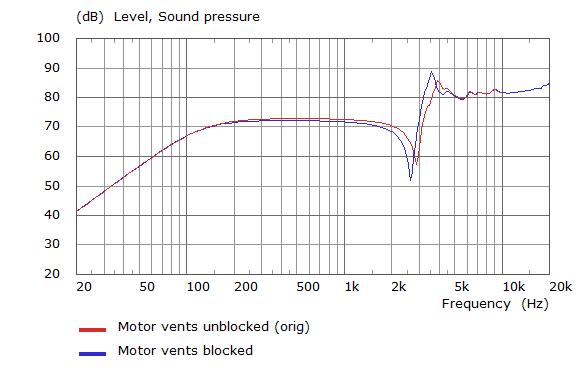
The effect of blocking the motor bass port(s) is that the resonance at 3.1kHz is slightly lowered in frequency and increased in magnitude.

The same effect is also evident in the experimental data albeit at a slightly higher frequency.
Effect of Bass Port with Damped Frame Vents
Similarly blocking the bass port when the frame vents are damped produces the frequency responses below.
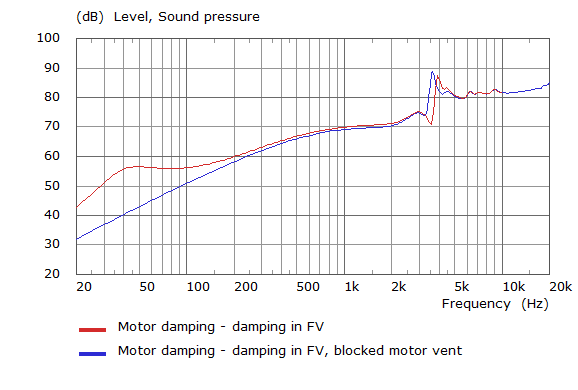
In the case where damping is applied to the frame vent holes, the model illustrates some tangible value of the bass port where a region of low frequency is raised. The effect on the upper response is the same as for when the frame vents were open.

The experimental results also confirm the simulated results where the bass response is lifted when the bass port is present. The dissimilarity between the two in terms of the mid-band response may be a combination of the frame vent damping model not sufficiently representing the real scenario and the slightly different cavity + port geometries producing different tunings.
I thought it might be interesting (as there are 4 motor vents comprising the bass port) in the real driver to see what happens when each of the 4 motor holes is blocked individually. The resulting responses are graphed below.

This family of curves shows the increasing influence of the bass port as more holes are opened, implying some tuning possibilities.. The frequency of the peak between 3kHz and 4kHz also changes, indicating that these holes influence this feature of the response.
Effect of Bass Port with Closed Frame Vents

The simulation shows that a null at 590Hz is introduced in addition to the raised bass response followed by a peak at 2kHz.
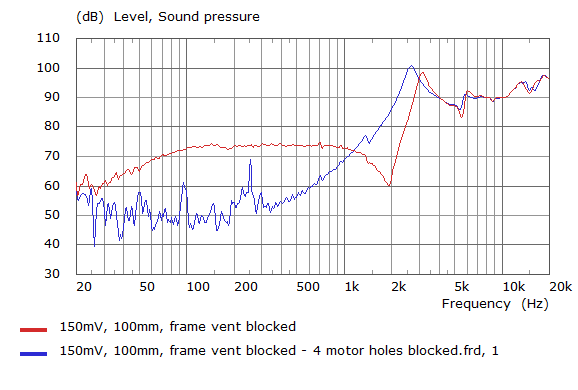
The experimental driver exhibits a similar null to that seen in the simulation, however this is a higher frequency, just under 2kHz - supporting the above idea that the mid-band response has dissimilar acoustic tuning. The peak that follow these null in the response shifts between the blocked and open bass port cases from 2.7 to 3.1kHz. Interestingly this was not observed in the simulation.
As before, a family of curves was generated to illustrate the intermediate effect of blocking the motor vent (bass port) holes in the experimental driver.

It can be seen that the dip in the midband frequency response and the following peaks are varied by the number of bass ports where fewer open holes results in a lower dip/ peak frequency.
Electrical impedance measurements can help clarify the situation. The graph below shows the result of measuring elecrical impedance for the experimental drivers when both the frame vents and the motor vents/ bass port are closed.
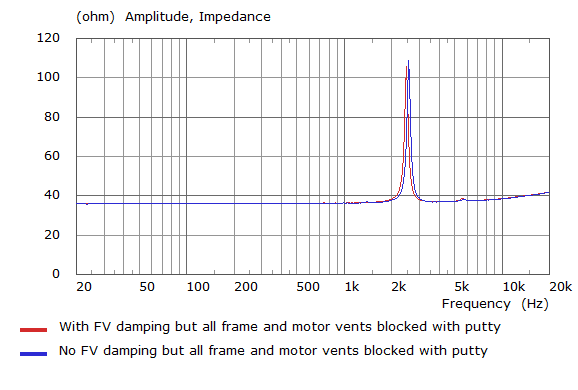
In the comparison above, both open and damped frame vent drivers are blocked with putty (so are equivalent) and therefore produce very similar impedance responses with a peak at ~2.4kHz which is effectively the new fundamental resonance of the driver. This is because the controlling air volume behind the diaphragm is constrained, increasing the effective mechanical stiffness of the "air spring".
Below shows what happens when the motor vents/ bass port are opened.
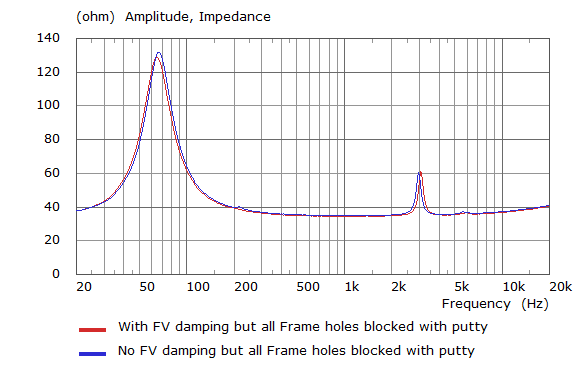
When the motor vents/ bass port are unblocked and are therefore the only ports communicating the air trapped behind the diaphragm with the outside, the resonance of the driver-port combination drops to ~65Hz (this was observed also in the damped frame vent case). There is also an upper resonance effect that is consistent with the peak in the frequency response when the bass ports are fully opened.
With consideration to the cases where the frame vents are open, damped and closed, the disappearance of the midband dip and peak characteristics that are present in the cases where the frame vents are blocked suggests that reducing the impedance of the frame vent holes reduces the influence of the bass port. In the open case, there is no evidence of bass enhancement. When resistance is applied to the frame vents via the felt/ paper damping layer, the bass port becomes increasingly activated and it becomes clear that a mechanism for tuning the bass output is created by controlling the frame vent absorption and bass port dimensions.




